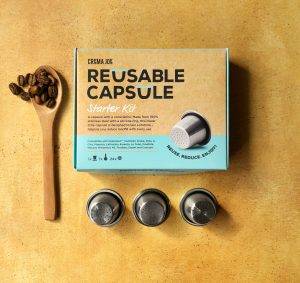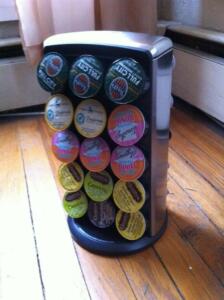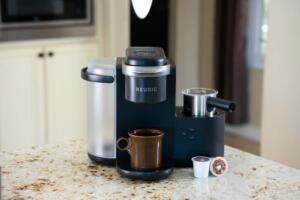K-Cups and other single-serve coffee pods are convenient, but is pod coffee all that progressive if it’s bad for the environment?
Table Of Contents
−Single-serve coffee pods and machines are the new things in the increasingly sophisticated world of coffee drinking. Coffee pods such as the popular K-Cups made by Green Mountain Coffee are perfect if you are looking for one good cup of coffee — rather than a whole pot that could become stale, or worse yet, dumped down the sink.

The only problem is waste. Pod coffee, at least in its present incarnation, is not eco-friendly. Is there a way to enjoy the freshness and convenience of gourmet coffee pods and single-serve coffee makers without creating a bigger environmental problem through excess waste and energy use?
What Are Single-Serve Coffee Pods?

Single-serve coffee pods are small individual containers designed to be used once for one cup of coffee and then discarded. They consist of the actual container, which is often made from non-biodegradable plastic, a single-serve filter, and the coffee, ground and ready to be brewed with a single-cup coffee maker.
How long does it take for a coffee pod to decompose?
Pods take up to 500 years to break down. These are made from a combination of plastics and aluminum, with coffee being the organic matter. The coffee pods are not biodegradable. It takes 150 to 500 years for aluminum and plastic capsules to break down in landfill.
There are different types and brands to choose from. Green Mountain K-Cups are extremely popular. The number of orders placed for coffee capsules grew by 53% over the past 12 months and accounted for more than half of all coffee orders online.
Nespresso and K-Cup, by Keurig, lead in online sales of coffee capsules in the United States. In 2014, more than 25 million Keurig® and K-Cup® Brewers were installed in homes and offices across America, with millions more being sold each quarter.
How many K cups are sold per year?
We don’t know the recent number. In 2016 Keurig’s K-Cup Coffee reportedly sold more than nine billion of its traditional single-serve plastic coffee pods — or K-Cup.
Why use coffee pods/k cups?
Not only are single-serve coffee pods convenient and ideal for a quick, high-quality cup of coffee, but they offer the consumer the freedom of choice. Gourmet coffee pods can be purchased in hundreds of different flavors, such as ‘Southern Pecan’ and ‘Mocha Nut Fudge.’ There are also hot chocolate K-Cups and tea pods as well.
K-Cups and other single-serve coffee pods are convenient, but is pod coffee all that progressive if it’s bad for the environment?

Single-serve coffee pods and machines are the new things in the increasingly sophisticated world of coffee drinking. Coffee pods such as the popular K-Cups made by Green Mountain Coffee are perfect if you are looking for one good cup of coffee — rather than a whole pot that could become stale, or worse yet, dumped down the sink.
The only problem is waste. Pod coffee, at least in its present incarnation, is not eco-friendly. Is there a way to enjoy the freshness and convenience of gourmet coffee pods and single-serve coffee makers without creating a bigger environmental problem through excess waste and energy use?
What Are Single-Serve Coffee Pods?
Single-serve coffee pods are small individual containers designed to be used once for one cup of coffee and then discarded. They consist of the actual container, which is often made from non-biodegradable plastic, a single-serve filter, and the coffee, ground and ready to be brewed with a single-cup coffee maker.
How long does it take for a coffee pod to decompose?
Pods take up to 500 years to break down. These are made from a combination of plastics and aluminum, with coffee being the organic matter. The coffee pods are not biodegradable. It takes 150 to 500 years for aluminum and plastic capsules to break down in landfill.
There are different types and brands to choose from. Green Mountain K-Cups are extremely popular. The number of orders placed for coffee capsules grew by 53% over the past 12 months and accounted for more than half of all coffee orders online.
Nespresso and K-Cup, by Keurig, lead in online sales of coffee capsules in the United States. In 2014, more than 25 million Keurig® and K-Cup® Brewers were installed in homes and offices across America, with millions more being sold each quarter.
How many K cups are sold per year?

We don’t know the recent number. In 2016 Keurig’s K-Cup Coffee reportedly sold more than nine billion of its traditional single-serve plastic coffee pods — or K-Cup.
Why use coffee pods/k cups?
Not only are single-serve coffee pods convenient and ideal for a quick, high-quality cup of coffee, but they offer the consumer the freedom of choice. Gourmet coffee pods can be purchased in hundreds of different flavors, such as ‘Southern Pecan’ and ‘Mocha Nut Fudge.’ There are also hot chocolate K-Cups and tea pods as well.
Pod Coffee and the Environment
What are the benefits of pod coffee for the environment? Theoretically, there is one environmental benefit to single-cup cup coffee pods — less coffee is wasted. The home kitchen, the office coffee room, or even the twenty-four-hour gas station coffee pots are brewed, but not all the contents are consumed.
With single-serve coffee pods, this problem is eliminated; only one cup is made at a time. If someone wants a second cup or another coffee drinker comes along, they can make a new fresh cup and even choose their flavor.
What are the cons of pod coffee for the environment?
The waste. At this point, K-Cups are not biodegradable or recyclable. The small amounts of ground coffee are tossed in the trash with the whole pod rather than being repurposed into a nitrogen-rich compost.
The other problem is energy use. Using single-serve coffee makers is not reducing anyone’s carbon footprint. Every time someone wants a cup of coffee, or a second cup, the machine has to use energy to brew each fresh cup. Drinking one cup a day is more eco-friendly for one individual. Multiple brews, however, use more energy than one pot being brewed and shared.
Eco-Friendly Solutions When Buying Coffee Pods and Single-Serve Coffee Makers

What do you do if you love single-serve coffee pods but are concerned about the environment? Try these tips to make what is available today as eco-friendly as possible.
- Producers like Keurig do not have Energy Star-rated coffee makers, but they have an ‘auto-off’ feature. Use it.
- Buy only fair trade coffee pods.
- While the petroleum-based K-Cups are not reusable, the coffee filters can be. Try using a reusable filter cartridge.
- Be aware of eco-friendly innovations. For example, Flavia pods offer businesses the option to send used pods to TerraCycle for the coffee to be composted and the plastic containers to be recycled.
- Pod coffee may not be the most environmentally-friendly option right now. Still, with a little more innovation, single-serve coffee pods may be compatible with all the needs of a progressive, eco-friendly society.
Pod Coffee and the Environment
What are the benefits of pod coffee for the environment? Theoretically, there is one environmental benefit from single-cup cup coffee pods — less coffee is wasted. The home kitchen, the office coffee room, or even the twenty-four-hour gas station coffee pots are brewed, but not all the contents are consumed.
With single-serve coffee pods, this problem is eliminated; only one cup is made at a time. If someone wants a second cup or another coffee drinker comes along, they can make a new fresh cup and even choose their flavor.
What are the cons of pod coffee for the environment?
The waste. At this point, K-Cups are not biodegradable or recyclable. The small amounts of ground coffee are tossed in the trash with the whole pod rather than being repurposed into a nitrogen-rich compost.
The other problem is energy use. Using single-serve coffee makers is not reducing anyone’s carbon footprint. Every time someone wants a cup of coffee, or a second cup, the machine has to use energy to brew each fresh cup. For one individual, drinking one cup a day is more eco-friendly. Multiple brews, however, use more energy than one pot being brewed and shared.
Eco-Friendly Solutions When Buying Coffee Pods and Single-Serve Coffee Makers
What do you do if you love single-serve coffee pods but are concerned about the environment? Try these tips to make what is available today as eco-friendly as possible.
- Producers like Keurig do not have Energy Star-rated coffee makers, but they have an ‘auto-off’ feature. Use it.
- Buy only fair trade coffee pods.
- While the petroleum-based K-Cups are not reusable, the coffee filters can be. Try using a reusable filter cartridge.
- Be aware of eco-friendly innovations. For example, Flavia pods offer businesses the option to send used pods to TerraCycle for the coffee to be composted and the plastic containers to be recycled.
Pod coffee may not be the most environmentally-friendly option right now. Still, with a little more innovation, single-serve coffee pods may be compatible with all the needs of a progressive, eco-friendly society.

Editorial Staff
The editorial staff at Crazy Coffee Crave is a team of coffee enthusiasts & Baristas who enjoy the one thing we all think about as soon as we get up in the morning. Trusted by thousands of readers worldwide.

